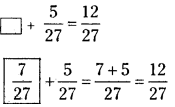Students can practice Telangana 6th Class Maths Textbook Solutions Chapter 7 Fractions and Decimals Ex 7.3 to get the best methods of solving problems.
TS 6th Class Maths Solutions Chapter 7 Fractions and Decimals Exercise 7.3
Question 1.
Write shaded portion as fraction. Arrange them in ascending or descending order using sign ‘<‘, ‘=’, ‘>’ between the fractions.
(i)

Answer:
\(\frac{3}{8}, \frac{6}{8}, \frac{4}{8}, \frac{1}{8}\); Arranging them in ascending order, we get \(\frac{1}{8}<\frac{3}{8}<\frac{4}{8}<\frac{6}{8}\)
Descending order: \(\frac{6}{8}>\frac{4}{8}>\frac{3}{8}>\frac{1}{8}\)
![]()
(ii)

Answer:
\(\frac{8}{9}, \frac{4}{9}, \frac{3}{9}, \frac{6}{9}\); Arranging them in ascending order, we get \(\frac{3}{9}<\frac{4}{9}<\frac{6}{9}<\frac{8}{9}\)
Descending order: \(\frac{8}{9}>\frac{6}{9}>\frac{4}{9}>\frac{3}{9}\)
Question 2.
Show \(\frac{2}{6}, \frac{4}{6}, \frac{8}{6}, \frac{5}{6}\) and \(\frac{6}{6}\) on the number line. Also arrange them in ascending order.
Answer:

Question 3.
Look at the figures and write ‘<‘ or’>’, ‘=‘ between the given pairs of fractions:

(i) \(\frac{1}{6}\) ________ \(\frac{1}{3}\)
(ii) \(\frac{3}{4}\) ________ \(\frac{2}{6}\)
(iii) \(\frac{2}{3}\) ________ \(\frac{2}{4}\)
(iv) \(\frac{6}{6}\) ________ \(\frac{3}{3}\)
(v) \(\frac{5}{6}\) ________ \(\frac{5}{5}\)
Make five more such problems and ask your friends to solve them.
Answer:
(i) \(\frac{1}{6}\) < \(\frac{1}{3}\)
(ii) \(\frac{3}{4}\) > \(\frac{2}{6}\)
(iii) \(\frac{2}{3}\)> \(\frac{2}{4}\)
(iv) \(\frac{6}{6}\) = \(\frac{3}{3}\)
(v) \(\frac{5}{6}\) < \(\frac{5}{5}\)
Question 4.
Fill with the appropriate sign. (‘<‘, ‘=’, ‘>’)
(i) \(\frac{1}{2}\) _______ \(\frac{1}{5}\)
Answer:
\(\frac{1}{2}\) > \(\frac{1}{5}\)
(ii) \(\frac{2}{4}\) _______ \(\frac{3}{6}\)
Answer:
\(\frac{2}{4}\) = \(\frac{3}{6}\)
(iii) \(\frac{3}{5}\) _______ \(\frac{2}{3}\)
Answer:
\(\frac{3}{5}\) < \(\frac{2}{3}\)
(iv) \(\frac{3}{4}\) _______ \(\frac{2}{8}\)
Answer:
\(\frac{3}{4}\) > \(\frac{2}{8}\)
![]()
(v) \(\frac{3}{5}\) _______ \(\frac{6}{5}\)
Answer:
\(\frac{3}{5}\) < \(\frac{6}{5}\)
(vi) \(\frac{7}{9}\) _______ \(\frac{3}{9}\)
Answer:
\(\frac{7}{9}\) > \(\frac{3}{9}\)
Question 5.
Answer the following. Also write how you solved them.
(i) Is \(\frac{5}{9}\) equal to \(\frac{4}{5}\)?
Answer:
We write the fractions \(\frac{5}{9}\) and \(\frac{4}{5}\) having the same denominators

(ii) Is \(\frac{9}{16}\) equal to \(\frac{5}{9}\)?
Answer:
We write the fractions \(\frac{9}{16}\) and \(\frac{5}{9}\) having the same denominators

(iii) Is \(\frac{4}{5}\) equal to \(\frac{16}{20}\)?
Answer:
We write the fractions \(\frac{4}{5}\) and \(\frac{16}{20}\) having the same denominators

(iv) Is \(\frac{1}{15}\) equal to \(\frac{4}{30}\)?
Answer:
We write the fractions \(\frac{1}{15}\) and \(\frac{4}{30}\) having the same denominators

Question 6.
Varshith read 25 pages of a story book containing 100 pages. Lalitha read \(\frac{2}{5}\) of the same story book. Who read less? Give reason.
Answer:
Total number of pages in the story book = 100
Number of pages that Varshith read = 25
Number of pages that Lalitha read
= \(\frac{2}{5}\) of 100
= \(\frac{2}{5}\) × 100 = 40
So, Varshith read less pages.
![]()
Question 7.
Fill the appropriate (+ or -) sign in the blank space.
(i)
![]()
Answer:
+
(ii)

Answer:
–
(iii)

Answer:
+
Question 8.
simplify:
(i) \(\frac{1}{18}+\frac{1}{18}\)
Answer:
\(\frac{1}{18}+\frac{1}{18}=\frac{1+1}{18}=\frac{2}{18}=\frac{1}{9}\)
(ii) \(\frac{8}{15}+\frac{3}{15}\)
Answer:
\(\frac{8}{15}+\frac{3}{15}=\frac{8+3}{15}=\frac{11}{15}\)
(iii) \(\frac{7}{7}-\frac{5}{7}\)
Answer:
\(\frac{7}{7}-\frac{5}{7}=\frac{7-5}{7}=\frac{2}{7}\)
(iv) \(\frac{1}{22}+\frac{21}{22}\)
Answer:
\(\frac{1}{22}+\frac{21}{22}=\frac{1+21}{22}=\frac{22}{22}\) = 1
(v) \(\frac{12}{15}-\frac{7}{15}\)
Answer:
\(\frac{12}{15}-\frac{7}{15}=\frac{12-7}{15}=\frac{5}{15}=\frac{1}{3}\)
(vi) \(\frac{5}{8}+\frac{3}{8}\)
Answer:
\(\frac{5}{8}+\frac{3}{8}=\frac{5+3}{8}=\frac{8}{8}\) = 1
(vii) 1 – \(\frac{2}{3}\)
Answer:
1 – \(\frac{2}{3}=\frac{3}{3}-\frac{2}{3}=\frac{3-2}{3}=\frac{1}{3}\) [∵ 1 = \(\frac{3}{3}\)]
(viii) \(\frac{1}{4}+\frac{0}{4}\)
Answer:
\(\frac{1}{4}+\frac{0}{4}=\frac{1+0}{4}=\frac{1}{4}\)
(ix) 3 – \(\frac{2}{15}\)
Answer:
3 – \(\frac{12}{5}=\frac{3 \times 5}{1 \times 5}-\frac{12}{5}=\frac{15}{5}-\frac{12}{5}=\frac{15-12}{5}=\frac{3}{5}\)
![]()
Question 9.
Fill in the missing fractions.
(i) \(\frac{7}{10}\) – ___________ = \(\frac{3}{10}\)
Answer:

(ii) ____________ – \(\frac{3}{21}\) = \(\frac{5}{21}\)
Answer:

(iii) ___________ – \(\frac{3}{3}\) = \(\frac{3}{6}\)
Answer:

(iv) ___________ + \(\frac{5}{27}\) = \(\frac{12}{27}\)
Answer:

Question 10.
Narendra painted \(\frac{2}{3}\) area of the wall in his room. His brother Ritesh helped and painted \(\frac{1}{3}\) area of the wall. How much did they paint together?
Answer:
Area of the wall painted by Narendra = \(\frac{2}{3}\)
Area of the wall painted by Ritesh = \(\frac{1}{3}\)
Area of the wall painted by both Narendra and Ritesh = \(\frac{2}{3}+\frac{1}{3}\)
= \(\frac{2+1}{3}\) = \(\frac{3}{3}\) = 1
∴ Narendra and his brother Ritesh painted the complete wall.
Question 11.
Neha was given \(\) of a basket of bananas. What fraction of bananas was left in the basket?
Answer:
The part of a basket of bananas given to Neha = \(\frac{5}{7}\)
The, part of bananas left in the basket
= 1 – \(\frac{5}{7}=\frac{1 \times 7}{1 \times 7}-\frac{5}{7}=\frac{7}{7}-\frac{5}{7}=\frac{7-5}{7}=\frac{2}{7}\)
Question 12.
A piece of rod \(\frac{7}{8}\) metre long is broken into two pieces. One piece was \(\frac{1}{4}\) metre long. How long is the other piece?
Answer:
Length of a piece of rod = \(\frac{7}{8}\) metre
Length of one broken piece of rod = \(\frac{1}{4}\) metre.
Length of the other piece = \(\frac{7}{8}-\frac{1}{4}\)
= \(\frac{7}{8}-\frac{1 \times 2}{4 \times 2}=\frac{7}{8}-\frac{2}{8}=\frac{7-2}{8}\) = \(\frac{5}{8}\)m
∴ \(\frac{5}{8}\)m long is the other piece.
![]()
Question 13.
Renu takes 2\(\frac{1}{5}\) minutes to walk around the school ground. Snigdha takes \(\frac{7}{4}\) minutes to do the same. Who takes less time and by what fraction?
Answer:
Time taken by Renu to walk around the school ground = 2\(\frac{1}{5}\) minutes
= \(\frac{11}{5}\)
Time taken by Snigdha to walk around the school ground = \(\frac{7}{4}\)minutes
To find the person who takes less time to do the same, we write the fractions \(\frac{11}{5}\) and \(\frac{7}{4}\) having the same denominators.
\(\frac{11}{5} \times \frac{4}{4}=\frac{44}{20}\); \(\frac{7}{4} \times \frac{5}{5}=\frac{35}{20}\)
We know that \(\frac{35}{20}\) < \(\frac{44}{20}\)
Therefore, Snigdha takes \(\frac{9}{20}\) minutes less time to walk around the school ground.
(∵ \(\frac{44}{20}-\frac{35}{20}=\frac{44-35}{20}=\frac{9}{20}\))